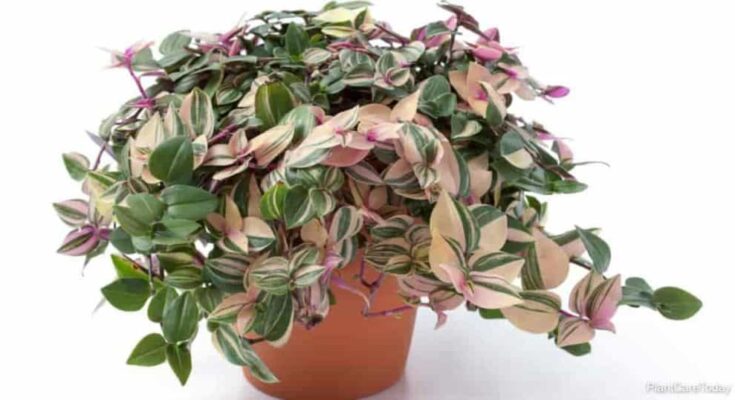Tradescantia fluminensis, commonly known as Tradescantia tricolor (trad-es-KAN-tee-uh TRY-kull-lur), is an herbaceous perennial cultivar hailing from the Caribbean, Central America, South America, and Mexico.

In the United States and many parts of the world, this cheery little plant is kept as a houseplant and goes by the common name “Wandering Jew” but also:
- Striped Wandering Jew
- Flowering Inch Plant
- Wandering Willie
- Wandering Gypsy
- Wandering Jew
- Purple Queen
- Tradescantia
- Spiderwort
- Inch Plant
This wandering jew plant is a member of the Commelinaceae plant family.
The genus name, Tradescantia, refers to John Tradescant, who was a gardener and botanist during the 17th Century.
The specific epithet, tricolor, refers to the plants’ coloration.
Tradescantia Tricolor Quick Care Tips
- Botanical Name: Tradescantia zebrina ‘Tricolor’
- Common Name(s): Tricolor Wandering Jew, Inch Plant, Striped Wandering Jew, Flowering Inch Plant, Wandering Willie, Wandering Gypsy, Purple Queen, Tradescantia, Spiderwort, Inch Plant
- Synonyms: Tradescantia pendula ‘Tricolor’
- Pronunciation: Trad-es-KAN-tee-uh TRY-kull-lur
- Family & Origin: Commelinaceae family, native to the Caribbean, Central America, South America, and Mexico
- Growability: Easy to grow
- Grow Zone: USDA zones 9-12
- Size: Grows up 6″ to 9″ inches tall and 1′ or 2′ feet wide
- Flowering: Produces small, pinkish-purple scentless flowers in the summer
- Light: Prefers bright, indirect light but can tolerate some shade
- Humidity: Prefers higher humidity levels but can tolerate lower levels
- Temperature: Thrives in temperatures between 65° – 75° degrees Fahrenheit
- Soil: Well-draining soil or any good quality regular potting mix
- Water: Weekly watering during the growing season
- Fertilizer: Feed a half-strength dose of time-release or water-soluble houseplant fertilizer twice a month
- Pests & Diseases: Susceptible to spider mites, aphids, and mealybugs, can also develop root rot if overwatered
- Propagation: Can be propagated through stem cuttings
- Plant Uses: Great for hanging baskets or as a trailing plant on shelves or in pots or ornamental ground cover. Adds a pop of color to any room.
Tradescantia Tricolor Care
Taking care of the Tradescantia zebrina tricolor is relatively easy. This includes providing proper Tradescantia rainbow care to ensure healthy growth.
Size And Growth
Striped Wandering Jew plants are fast growers and typically attain a height of 6″ to 9″ inches with a spread of 1′ or 2′ feet.
They commonly have green leaves with purplish undersides.
- Tradescantia Callisia has boldly striped green and white variegation in the leaves.
- Tradescantia Zebrina pendula have striped, reddish leaves.
- Tradescantia pallida have solid purple leaves.
Flowering And Fragrance
There are several species of Tradescantia, and the small clusters of triangular-shaped flowers that display three small petals and sepals vary in color from one species to the other.
They grow at small tips and typically come in shades of white, pink, rose, or purple.
The scentless flowers of tri color wandering jew bloom perpetually.
Light And Temperature
- Tri-color tradescantia does well in bright, indirect sunlight.
- Too little sunlight will result in faded leaves with little or no variegation.
- Excessive direct sunlight causes leaf scorch. However, it can grow in direct sun with afternoon protection.
- All Wandering Jew species perform best at tropical temperatures between 65 ° and 75 ° Fahrenheit (18° and 24° C); however, they can withstand higher temperatures.
- The leaves will suffer if the temperature drops below 50° degrees Fahrenheit (10° C).
- All species of Tradescantia are winter hardy in USDA hardiness zones 9-12.
- All do well as houseplants in any climate with bright light.
Watering And Feeding
- Rainbow tradescantia likes soil that is not bone dry nor soggy.
- Allow the soil to almost dry out before watering thoroughly.
- Generally speaking, a good schedule includes weekly watering during the growing season (spring—fall) and reduced watering in winter.
- Inch plant is not a heavy feeder and may not need feeding at all.
- If you decide to feed your Tradescantia albiflora tricolor, give it a half-strength dose of time-release, water-soluble houseplant fertilizer no more than twice a month.
- Too much fertilizer causes green leaves to lose variegation.
Moist Soil And Transplanting
Wandering Jew does well in any good quality regular potting mix.
It is not picky about pH levels and appreciates a bit of sand or perlite mixed in for improved drainage.
Repot this subsucculent perennial herb to the next size container annually in the springtime.
Grooming And Maintenance
Tradescantia earns its common name because it likes to wander.
Tradescantia mundula tricolor grows quickly, rambles freely, and tends to get leggy.
To maintain a full, bushy shape, pinch or trim back the stems regularly.
The Wandering jew tricolor tends to be fairly short-lived but easily replaces itself because of cutting roots enthusiastically.
You can also pinch stems to encourage foliage growth.
How To Propagate Tricolor Tradescantia
Spiderwort cuttings are rooted in fresh potting soil or water.
Take a cutting at least an inch long with a minimum of one leaf.
Remove any leaves from the lower part of the stem.
Poke the prostrate stems into a clean, moist potting mix or put it into a little jar of water.
You’ll see roots within a week.
If rooting in water, go ahead and put the cutting into the soil when several strong roots have grown at each node.
Tradescantia Tricolour Pest or Diseases
- Too much water will cause root rot.
- Be sure to provide well-draining soil, and take care not to water too often or too much.
- Wandering Willie may have problems with spider mites and aphids.
- If you see these pests in residence, give your plant a good shower to wash them off.
- If they persist, use a concoction of pesticidal soap or neem oil to combat them. You can also find other chemical solutions available.
- Variegated leaves may become pale and monochrome in reaction to excessive fertilizer, low temperatures, or too much sun.
- Be sure to provide the right setting and care for the best leaf performance.
Is The Tradescantia Toxic Or Poisonous?
Tradescantia sap is irritating and may cause gastric distress in cats who ingest the leaves.
For more, check out our article on the question – Is Wandering Jew Poisonous?
Direct contact with the sap can cause skin irritation.
If you believe your cat or dog has eaten Wandering Jew or rolled in a patch of it, watch for vomiting and check to see if your pet is experiencing dermatitis.
Symptoms usually manifest in these areas:
- Around the mouth
- In the groin area
- Under the chin
- On the belly
Contact your vet and/or poison control for assistance in treating these symptoms.
Is The Tricolor Tradescantia Plant Invasive?
Although Tradescantia tricolor plant is not listed as invasive species by the state of Florida, it bears watching if you have it planted outdoors.
It flourishes as an outdoor plant in any tropical or semi-tropical setting.
The Tradescantia fluminensis tricolour grows and spreads rapidly and could easily become invasive, making it known as a pest plant in many locations.
Suggested Transcendia Plant Uses
As a houseplant, Wandering Gypsy is a great choice for a hanging basket planted in pots or containers placed on pedestals or a high shelf.
The evergreen trailing herbaceous perennial’s growth habit allows them to dangle prettily in these situations, as long as there is plenty of bright, indirect sunlight to be had.
As an outdoor plant, Flowering Inch Plant is used as a dense ground cover in a wide variety of settings, including the tropics and subtropics, Mediterranean and temperate areas, and even in the desert, as long as ample water is provided.



